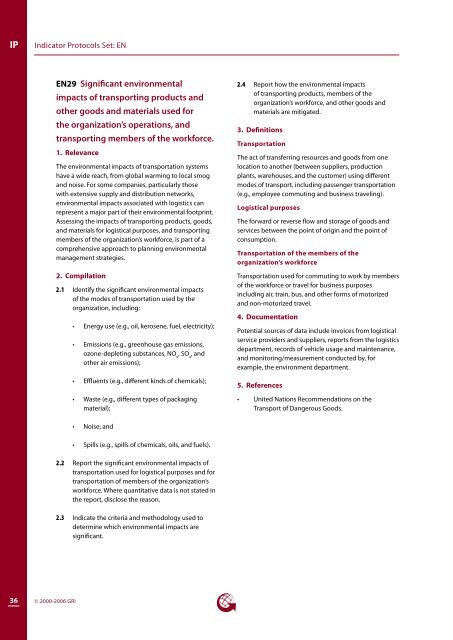Environment - Global Reporting Initiative
Environment - Global Reporting Initiative
Environment - Global Reporting Initiative
You also want an ePaper? Increase the reach of your titles
YUMPU automatically turns print PDFs into web optimized ePapers that Google loves.
IP<br />
Indicator Protocols Set: EN<br />
EN29 Significant environmental<br />
impacts of transporting products and<br />
other goods and materials used for<br />
the organization’s operations, and<br />
transporting members of the workforce.<br />
1. Relevance<br />
The environmental impacts of transportation systems<br />
have a wide reach, from global warming to local smog<br />
and noise. For some companies, particularly those<br />
with extensive supply and distribution networks,<br />
environmental impacts associated with logistics can<br />
represent a major part of their environmental footprint.<br />
Assessing the impacts of transporting products, goods,<br />
and materials for logistical purposes, and transporting<br />
members of the organization’s workforce, is part of a<br />
comprehensive approach to planning environmental<br />
management strategies.<br />
2. Compilation<br />
2.1 Identify the significant environmental impacts<br />
of the modes of transportation used by the<br />
organization, including:<br />
• Energy use (e.g., oil, kerosene, fuel, electricity);<br />
• Emissions (e.g., greenhouse gas emissions,<br />
ozone-depleting substances, NO x<br />
, SO x<br />
, and<br />
other air emissions);<br />
• Effluents (e.g., different kinds of chemicals);<br />
• Waste (e.g., different types of packaging<br />
material);<br />
2.4 Report how the environmental impacts<br />
of transporting products, members of the<br />
organization’s workforce, and other goods and<br />
materials are mitigated.<br />
3. Definitions<br />
Transportation<br />
The act of transferring resources and goods from one<br />
location to another (between suppliers, production<br />
plants, warehouses, and the customer) using different<br />
modes of transport, including passenger transportation<br />
(e.g., employee commuting and business traveling).<br />
Logistical purposes<br />
The forward or reverse flow and storage of goods and<br />
services between the point of origin and the point of<br />
consumption.<br />
Transportation of the members of the<br />
organization’s workforce<br />
Transportation used for commuting to work by members<br />
of the workforce or travel for business purposes<br />
including air, train, bus, and other forms of motorized<br />
and non-motorized travel.<br />
4. Documentation<br />
Potential sources of data include invoices from logistical<br />
service providers and suppliers, reports from the logistics<br />
department, records of vehicle usage and maintenance,<br />
and monitoring/measurement conducted by, for<br />
example, the environment department.<br />
5. References<br />
• United Nations Recommendations on the<br />
Transport of Dangerous Goods.<br />
• Noise; and<br />
• Spills (e.g., spills of chemicals, oils, and fuels).<br />
2.2 Report the significant environmental impacts of<br />
transportation used for logistical purposes and for<br />
transportation of members of the organization’s<br />
workforce. Where quantitative data is not stated in<br />
the report, disclose the reason.<br />
2.3 Indicate the criteria and methodology used to<br />
determine which environmental impacts are<br />
significant.<br />
36<br />
© 2000-2006 GRI

















